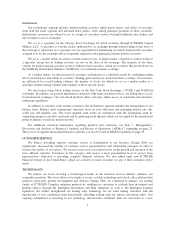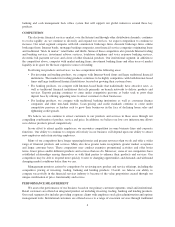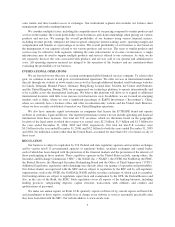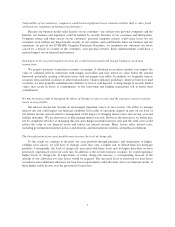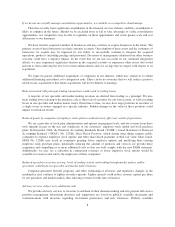eTrade 2006 Annual Report Download - page 13
Download and view the complete annual report
Please find page 13 of the 2006 eTrade annual report below. You can navigate through the pages in the report by either clicking on the pages listed below, or by using the keyword search tool below to find specific information within the annual report.If we do not maintain the capital levels required by regulators, we may be fined or even forced out of business
The SEC, NASDAQ, NASD, OTS and various other regulatory agencies have stringent rules with respect to
the maintenance of specific levels of net capital by securities broker-dealers and regulatory capital by banks. Net
capital is the net worth of a broker or dealer (assets minus liabilities), less deductions for certain types of assets.
Failure to maintain the required net capital could result in suspension or revocation of registration by the SEC
and suspension or expulsion by the NASDAQ and/or NASD, and could ultimately lead to the firm’s liquidation.
In the past, our broker-dealer subsidiaries have depended largely on capital contributions by us in order to
comply with net capital requirements. If such net capital rules are changed or expanded, or if there is an
unusually large charge against net capital, operations that require an intensive use of capital could be limited.
Such operations may include investing activities, marketing and the financing of customer account balances.
Also, our ability to withdraw capital from brokerage subsidiaries could be restricted, which in turn could limit
our ability to repay debt and redeem or purchase shares of our outstanding stock.
Similarly, the Bank is subject to various regulatory capital requirements administered by the OTS. Failure to
meet minimum capital requirements can trigger certain mandatory, and possibly additional discretionary actions
by regulators that, if undertaken, could harm a bank’s operations and financial statements. A bank must meet
specific capital guidelines that involve quantitative measures of a bank’s assets, liabilities and certain off-balance
sheet items as calculated under regulatory accounting practices. A bank’s capital amounts and classification are
also subject to qualitative judgments by the regulators about the strength of components of its capital, risk
weightings of assets, off-balance sheet transactions and other factors.
Quantitative measures established by regulation to ensure capital adequacy require a bank to maintain
minimum amounts and ratios of Total and Tier 1 Capital to Risk-weighted Assets and of Tier 1 Capital to
adjusted total assets. To satisfy the capital requirements for a “well capitalized” financial institution, a bank must
maintain higher Total and Tier 1 Capital to Risk-weighted Assets and Tier 1 Capital to adjusted total assets
ratios.
As a non-grandfathered savings and loan holding company, we are subject to regulations that could restrict our
ability to take advantage of certain business opportunities
We are required to file periodic reports with the OTS and are subject to examination by the OTS. The OTS
also has certain types of enforcement powers over us, ETB Holdings, Inc. and certain of its subsidiaries,
including the ability to issue cease-and-desist orders, force divestiture of the Bank and impose civil and monetary
penalties for violations of Federal banking laws and regulations or for unsafe or unsound banking practices. In
addition, under the Gramm-Leach-Bliley Act, our activities are restricted to those that are financial in nature and
certain real estate-related activities. We may make merchant banking investments in companies whose activities
are not financial in nature if those investments are made for the purpose of appreciation and ultimate resale of the
investment and we do not manage or operate the company. Such merchant banking investments may be subject
to maximum holding periods and special recordkeeping and risk management requirements. The Company has
also proposed to move its indirect subsidiary, E*TRADE Clearing, LLC to become an operating subsidiary of
E*TRADE Bank. Such a move could result in increased regulatory oversight and restrictions on the activities of
E*TRADE Clearing, LLC.
We believe all of our existing activities and investments are permissible under the Gramm-Leach-Bliley
Act, but the OTS has not yet fully interpreted these provisions. Even if our existing activities and investments are
permissible, we are unable to pursue future activities that are not financial in nature. We are also limited in our
ability to invest in other savings and loan holding companies.
In addition, the Bank is subject to extensive regulation of its activities and investments, capitalization,
community reinvestment, risk management policies and procedures and relationships with affiliated companies.
Acquisitions of and mergers with other financial institutions, purchases of deposits and loan portfolios, the
10





